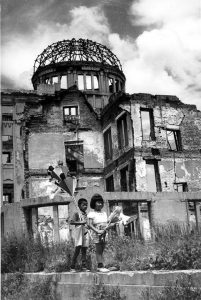Documenting Hiroshima 80 years after A-bombing: In summer 1950, name “A-bomb Dome” used for first time
Feb. 17, 2025
by Kyosuke Mizukawa, Senior Staff Writer
In the summer of 1950, five years after the atomic bombing, the ruined remains of the Hiroshima Prefectural Industrial Promotion Hall, next to which stood children holding ceremonial paper lanterns, was inscribed with memories of the tragedy that had befallen the city. In an editorial carried in the Chugoku Shimbun dated June 23, 1950, the ruins of the Industrial Promotion Hall were called the “A-bomb Dome,” in what is now considered to have been the first instance of use of the name in the pages of a newspaper. In the summer of 1951, the name was seen in a smattering of newspapers and magazines. After Japan regained its independence following the entry into force of the San Francisco Peace Treaty on April 28, 1952, the name started to be used more commonly.
In June of 1950, the Korean War broke out. The efforts to communicate what the atomic bombing had brought about for humanity continued despite constraints in place during Japan’s occupation. Once the restrictions were lifted, those efforts gained further momentum. Meanwhile, in 1954, when the United States conducted a hydrogen bomb test on the Bikini Atoll in the Marshall Islands in the central Pacific Ocean, the tuna fishing boat the Daigo Fukuryu Maru (Lucky Dragon No. 5) was exposed to radiation fallout from the test. With that, the crisis of the nuclear age deepened even further.
(Originally published on February 17, 2025)
In the summer of 1950, five years after the atomic bombing, the ruined remains of the Hiroshima Prefectural Industrial Promotion Hall, next to which stood children holding ceremonial paper lanterns, was inscribed with memories of the tragedy that had befallen the city. In an editorial carried in the Chugoku Shimbun dated June 23, 1950, the ruins of the Industrial Promotion Hall were called the “A-bomb Dome,” in what is now considered to have been the first instance of use of the name in the pages of a newspaper. In the summer of 1951, the name was seen in a smattering of newspapers and magazines. After Japan regained its independence following the entry into force of the San Francisco Peace Treaty on April 28, 1952, the name started to be used more commonly.
In June of 1950, the Korean War broke out. The efforts to communicate what the atomic bombing had brought about for humanity continued despite constraints in place during Japan’s occupation. Once the restrictions were lifted, those efforts gained further momentum. Meanwhile, in 1954, when the United States conducted a hydrogen bomb test on the Bikini Atoll in the Marshall Islands in the central Pacific Ocean, the tuna fishing boat the Daigo Fukuryu Maru (Lucky Dragon No. 5) was exposed to radiation fallout from the test. With that, the crisis of the nuclear age deepened even further.
(Originally published on February 17, 2025)








